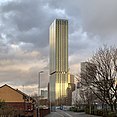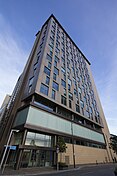St Philip's Church, Salford
This article contains content that is written like an advertisement. (July 2018) |
| St Philip's Church, Salford | |
|---|---|
 St Philip's Church, Salford, from the south | |
 St Philip's Church, Salford Location in Greater Manchester | |
| Coordinates: 53°29′02″N 2°15′47″W / 53.4840°N 2.2631°W | |
| OS grid reference | SJ 826 986 |
| Location | Wilton Place, Salford, Greater Manchester |
| Country | England |
| Denomination | Anglican |
| Website | St Philip, Salford |
| History | |
| Status | Parish church |
| Architecture | |
| Functional status | Active |
| Heritage designation | Grade II* |
| Designated | 31 January 1952 |
| Architect(s) | Sir Robert Smirke |
| Architectural type | Church |
| Style | Greek Revival |
| Groundbreaking | 1822 |
| Completed | 1824 |
| Construction cost | £14,670[1] |
| Specifications | |
| Materials | Stone |
| Administration | |
| Parish | St Philip with St Stephen, Salford |
| Deanery | Salford |
| Archdeaconry | Salford |
| Diocese | Manchester |
| Province | York |
| Clergy | |
| Rector | Rev Gareth Robinson |
| Curate(s) | Rev Matthew Brinicombe |
St Philip's Church is an Anglican parish church in the deanery and archdeaconry of Salford, and the diocese of Manchester.[2] Located at Wilton Place, just off Chapel Street in Salford, Greater Manchester, England, the church was relaunched in 2016 as Saint Philip's Chapel Street, and has been described as an old church on a new journey.
The building is recorded in the National Heritage List for England and is designated as a Grade II* listed building.[3] It was a Commissioners' church, having received a grant towards its construction from the Church Building Commission.[4] In planning the church, its architect, Sir Robert Smirke re-used his design for St Mary's Church, Bryanston Square, London. The was also used for St Anne's Church, Wandsworth.[1]
History[]
The church was built between 1822 and 1824 to a design by Smirke.[1] A grant of £16,804 (equivalent to £1,510,000 in 2020)[5] was given towards its construction by the Church Building Commission.[4][A] The interior of the church was re-ordered in 1895 by .[1] In 1962, the nearby church of St Stephen closed, and the parishes merged to form the parish of .[6]
Architecture[]
Exterior[]
St Philip's is constructed in ashlar stone.[3] Its architectural style is Greek Revival.[1] It has an undivided plan, with a semicircular portico to the south surmounted by a bell tower. The body of the church is expressed as two storeys. The windows in the upper storey are round-headed, and those in the lower storey are straight-headed. There are nine bays along the north and south sides, and three bays along the east and west sides. The central three bays on the south side are occupied by the portico that encloses a semicircular porch. The portico is carried on an Ionic colonnade with a balustraded parapet. The bell tower has plain pilasters between, which are round-arched openings that are alternately open and blind. Above this stage are four clock faces, and the summit is capped by a dome.[3] The clock was made by of Derby.[1] On the west front are three doorways; the central bay projects slightly forwards, and has a pediment above the doorway.[3]
Interior[]
Inside the church are galleries on three sides. The stained glass in the east window dates from the mid to late 19th Century, and was designed by of Manchester. In the southeast chapel is a memorial to the First World War by Humphries, Jackson and Ambler, also of Manchester.[1] The two-manual organ was made by Renn and Boston in 1829. It was moved forwards from a position above the west door to the west gallery in 1873 by , who also carried out modifications. The organ was cleaned and restored in 1915 by Wadsworth and Company.[7] In 1963, Noel Mander, who respected the historical importance of the instrument, carried out a further restoration that reversed some of 1873 modifications.[8][9]
Present day[]
Services and other activities[]
St Philips gather to worship at 9:30am (Common Worship Communion service), 10:45am (contemporary service, including groups for children), and 6:30pm (contemporary service, including groups for young people) each Sunday.
In addition to church services on Sundays, the church is used for concerts, recitals and community activities.[9] It is open to visitors between 10am and 4pm on Wednesdays.[6]
It runs many community activities, groups, and initiatives throughout the week, including Alpha for those exploring the Christian faith, Chapel Tots, KidsLife for primary school aged children, Bags of Hope, student groups, and much more.
Saint Philips work closely with St Philip's Church of England Primary School, located on Barrow Street.
See also[]
- Grade II* listed buildings in Greater Manchester
- Listed buildings in Salford, Greater Manchester
- List of Commissioners' churches in Northeast and Northwest England
Notes[]
A In some cases, as in this one, the size of the grant was greater than the actual construction cost (as shown in the infobox) because it also included contributions towards the cost of the site, legal fees, etc.[4]
References[]
- ^ a b c d e f g Hartwell, Clare; Hyde, Matthew; Pevsner, Nikolaus (2004), Lancashire: Manchester and the South-East, The Buildings of England, New Haven and London: Yale University Press, p. 619, ISBN 0-300-10583-5
- ^ St Philip w St Stephen, Salford, Church of England, retrieved 12 December 2011
- ^ a b c d Historic England, "Church of St Philip, Salford (1386165)", National Heritage List for England, retrieved 12 December 2011
- ^ a b c Port, M. H. (2006), 600 New Churches: The Church Building Commission 1818-1856 (2nd ed.), Reading: Spire Books, p. 327, ISBN 978-1-904965-08-4
- ^ UK Retail Price Index inflation figures are based on data from Clark, Gregory (2017), "The Annual RPI and Average Earnings for Britain, 1209 to Present (New Series)", MeasuringWorth, retrieved 2 December 2021
- ^ a b St Philip with St Stephen, Salford, Church of England, retrieved 12 December 2011
- ^ "NPOR [N01588]", National Pipe Organ Register, British Institute of Organ Studies, retrieved 2 July 2020
- ^ "NPOR [N06094]", National Pipe Organ Register, British Institute of Organ Studies, retrieved 2 July 2020
- ^ a b Scott. "Organ recital series".
External links[]
- Saint Philips Chapel Street Website
- Church of England church buildings in Greater Manchester
- Anglican Diocese of Manchester
- 19th-century Church of England church buildings
- Neoclassical architecture in England
- Commissioners' church buildings
- Churches in Salford
- Grade II* listed churches in Greater Manchester





